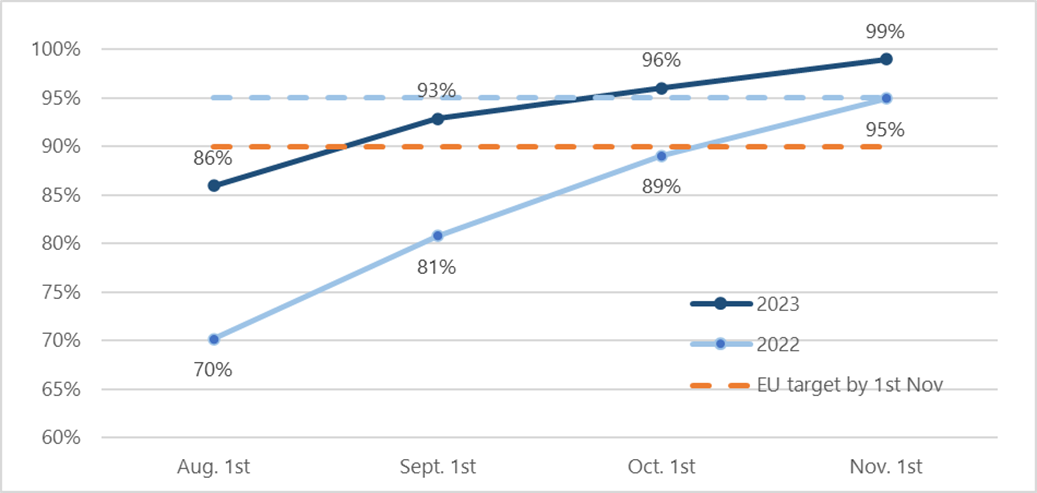- Our DNA
- Innovation Lab
- Publications
- Energy Transparency
- Press Corner
- Events
- Contact
- Subscribe
- Membernet
- My account
- Search
- Follow us at LinkedIn
- Follow us on Twitter
- Follow us on Instagram
November 2, 2023
The first November marks a significant milestone for Europe’s security of supply, with European gas storage nearly full. While the gas filling levels achieved in 2022 were already high, they have reached new records in 2023, close to full as heating season begins.

Download this graph;
visit https://agsi.gie.eu
EU’s gas storage capacities almost 100% full, far exceeding targets
The European Union has accumulated record amounts of natural gas in its gas storage capacities and has done ahead of its own schedule.
The news was announced in August by the Commissioner for Energy, Kadri Simson, closely monitoring the filling of storage capacities as a key parameter of the resiliency of the energy system.
By mid-August, the storage capacities were full at 90%, the November target (set in the gas regulation). As of 1st October, gas storage capacities were filled up to 96%, exceeding the record of the winter of 2022. As of 1 November, gas storage in the EU is now close to 100% full, reaching an all-time high.
“This success underscores our unwavering commitment to safeguarding Europe’s energy supply. Full underground gas storages help the European gas market to be more resilient than last year, entering the winter season in a state of greater preparedness.”
Charlotte Roule, President of Gas Storage Europe (GSE)
In an increasingly globalised European gas market, the role of gas storage takes an additional dimension in the security of supply by further enabling us to stabilise the European market but also regional markets outside Europe.
Nevertheless, some risks should not be underestimated as the market will likely be tight for several years before Europe can strengthen its position through investments in renewables and energy efficiency.
While the EU gas storage regulation rules to fill up storages up to at least 90% ahead of the winter end in 2025, some EU Member States have already extended the gas storage-related Security of Supply rules beyond 2025 to meet the challenges ahead and prepare themselves for security of supply in the coming years.
Gas Infrastructure Europe (GIE) is the association representing the interests of European gas infrastructure operators active in gas transmission, gas storage and Liquefied Natural Gas (LNG) regasification. GIE is a trusted partner of European institutions, regulatory bodies and industry stakeholders. It is based in Brussels, the heart of European policymaking. GIE currently represents 70 member companies from 26 countries. GIE’s vision is that by 2050, the gas infrastructure will be the backbone of the new innovative energy system, allowing European citizens to benefit from a secure, efficient and sustainable energy supply.
Downloads





































































